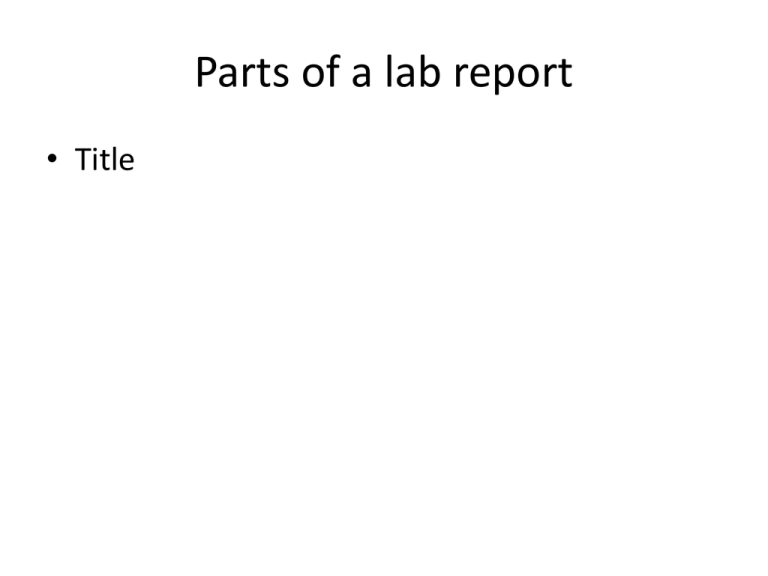hypothesis
advertisement

Parts of a lab report • Title ABSTRACT-at the end! • Abstract: A summary of what you did and what your data suggests (what you found). 75-150 words EXAMPLE The purpose of this experiment was to measure and compare the spring constant of a steel spring using two different procedures. First we investigated the relationship between the force applied to a spring and the displacement of the spring from its rest length. We hung various masses from the springs, and measured the vertical displacement. We found a spring constant of 2.94 ± 0.01 N/m. Our results confirmed Hooke’s Law, Fs = -kx. In the second procedure, we set the spring into vertical oscillation with a suspended mass and measured the period of oscillation. Using this method, we found a spring constant of 2.98 ± 0.02 N/m. Our results verified that the period of oscillation depended on the effective mass of the spring and the period of oscillation. (128 words) • INTRODUCTION: • A good introduction does exactly what the word implies – it poses the problem being investigated. In the laboratory, the instructor or the textbook usually poses those questions. These questions become the objectives of the experiment. A comprehensive introduction also includes background information about the problem being studied. In preparing the report, other sources should be consulted, such as: laboratory manuals, textbooks, and Internet/library resources. This is where your research goes. The more info you give the better. At least 8 sentences. • HYPOTHESIS: an “if..., then...” statement telling what you expect to happen. Research • Research: what causes heartburn, what are the symptoms, what are the common treatments, how do those treatments work, what is the optimal pH of the stomach, what happens if someone takes too much heartburn medicine Materials • Bullet point list Procedure • Step by step instructions • listed as 1,2,3… steps • They should be specific enough that a random person could go into the lab and preform it the exact way you did it • Present tense • No I, you, we statements • “Prepare the heartburn environment by pouring 5 mL of HCl into 200mL of water” Results • RESULTS/DATA: • This section of your report may actually include little writing. Typically, data is displayed within tables or graphs. These formats allow the reader to clearly understand the relationships between different kinds of data. During experimentation, cause and effect relationship may have been noted (e.g., when the temperature was increased, the reaction rate also increased). These types of relationships suggest a logical format for a table or a graph. Be sure to label: table columns, axes of graphs, and include titles. • Passive tense (“The tums brought the pH of the heartburn environment to a 5”) Grading • • • • • • • • • • • • • • • • • • • • • • • • • • • 1 point off for each grammatical error (2 pts.) Research Question and Title (10 pts) Abstract (15 pts) Introduction (5 pts.) Hypothesis Includes: Independent variable (include units of measurement, if applicable) Dependent variable (include units of measurement) Constants Hypothesis (“if..., then...., because” format) (15 pts.) Materials and Procedure (15 pts.) Results/data: -Data Tables (properly labeled, with appropriate title) -Graphs (properly labeled, with appropriate title) -Calculations (if applicable) -Visual representation (photo or diagram of experiment) (18 pts.) Conclusion/discussion Includes: -1 point for reference to purpose of the lab and the research question -5 points for the evaluation of the hypothesis using specific observations and data points -5 points for drawing conclusions from the lab that relate to the scientific theories or concepts based upon evidence from the experiment - 2 points for the two sources of error -2 points for addressing how you might improve the experiment if you were to do it again in the future (5 pts.) Overall Appearance and neatness/organization of report (5 pts ) Bibliography Conclusion/Discussion • What is your conclusion based on the results you obtained. How does it relate to your hypothesis. DO you accept or reject your hypothesis. • What were some things that could be improved on in your experiment? What could you do different to make your data more accurate or significant? • 2 sources of error • If you were to redesign the experiment how would you do it differently? • Who would benefit from the results of this experiment? How? • Who would not benefit or may be negatively affected by the results of this experiment? How? • BIBLIOGRAPHY: • It is important to include a bibliography including all sources of information for the report. Information used in the report should be cited, even if the information is paraphrased. When the report has been completed, it should be carefully proofreademphasis on style, content, spelling, grammar and detail. Today • • • • • • • Brainstorm ideas Title Hypothesis Introduction Materials list Procedure Bibliography • You will want to create a heartburn environment using hydrochloric acid, water, and crushed up food (optional). You will want to test each remedy on each heartburn environment using pH paper.




